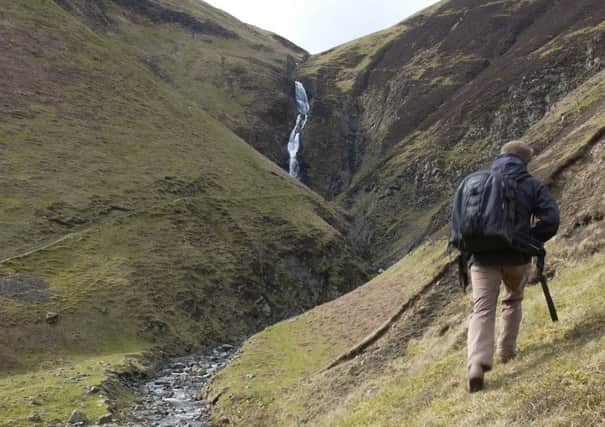5 of the most famous Scottish walks


However, there are also other equally worthwhile and enjoyable walks elsewhere in Scotland. Take a look at our favourite Scottish walks, and choose your next big adventure.
(Length: 154,500 km, Start point: Glasgow, Finish point: Fort William, Skill level: All levels)
Advertisement
Hide AdAdvertisement
Hide AdThis is Scotland’s first long-distance walking route, and also one of the most popular, both with experienced walkers and with novices. The West Highland Way is 154.5 km in length, and usually takes a week to eight days to complete. However, some walkers can finish it in five or six days, if they really make an effort.
The walk begins at Milngavie, on the outskirts of Glasgow, and finishes at Fort William in the Highlands. The terrain is very varied, encompassing farming land, hills and mountains.
The route goes along Loch Lomond, and takes in Conic Hill on the Highland Boundary Fault. Walkers will also be impressed by the wild Rannoch Moor, and the dramatic Glencoe.
The final destination of Fort William is reached by Glen Nevis, home to Britain’s highest peak, Ben Nevis. Many walkers round off their journey by climbing the mountain, and enjoying the fabulous panorama of the glen from the summit.
The most avid walkers can continue their trip by joining the Great Glen Way, which begins where the West Highland Way ends.
Although this walk avoids the highest ground, there are still challenging sections, including the east side of Loch Lomond, with other exposed areas along the route.
GREAT GLEN WAY
(Length: 117km, Start point: Fort William, Finish point: Inverness Skill level: All levels)
Advertisement
Hide AdAdvertisement
Hide AdThis walk is 117 km long, and spans the breadth of the country, from coast to coast. Walkers can explore the natural fault-line of the Great Glen, and discover many Highland lochs on the way. Loch Linnhe, Loch Lochy, Loch Oich and the Loch Ness are among the great bodies of water that you will see on your journey.
If you are a novice walker, this is a good route to begin with. However, there is also a more challenging version for experienced walkers, which takes in higher ground between Fort Augustus and Drumnadrochit.
The Caledonian Canal is another notable point on the journey. It was built by Thomas Telford to link the lochs to the Moray Firth.
The route begins at Fort William, and ends at Inverness Castle, in the Highlands’ main city.
FIFE COASTAL PATH
(Length: 188 km Start point: North Queensferry, Finish point: Tayport, Skill level: All levels)
This delightful coastal walk stretches between the Forth and the Tay estuaries, between Kincardine and Newburgh. When the path was created in 2002, it ran from North Queensferry to Tayport, and was extended in 2012, to make a total distance of 180 km.
Walkers will encounter a number of charming former fishing villages and seaside towns on their way, such as Crail.
Advertisement
Hide AdAdvertisement
Hide AdAnother notable stop on the journey is the historic town of St Andrews, the home of golf in Scotland. Visitors can also see the magnificent university buildings and the ruined cathedral.
Aberdour Castle is well worth a visit, as is Macduff’s Castle near East Wemyss.
On the south bank of the Tay, walkers will come across the scene of one of Britain’s greatest rail disasters. Between the towns, there are several golden beaches and nature reserves which will bring joy to nature enthusiasts and bird watchers.
The industrial towns of Kirkcaldy and Leven are also on the route, providing some variety, as well as some former coal yards.
The path between Crail and St Andrews is the most challenging part of the walk, but otherwise, the going is pretty easy.
BORDERS ABBEYS WAY
(Length: 107km Start point: Jedburgh, Finish point: Jedburgh, Skill level: All levels)
The Borders of Scotland are famous for their majestic ruined abbeys, which were built by King David I of Scotland in the 12th century. They were inhabited by monks right up up to the 16th century.
Advertisement
Hide AdAdvertisement
Hide AdThe Borders Abbeys Way links all four of the abbeys in a circular route. You can start the walk at any point, and finish where you began. The entire Way is 107 km long, and comprises five stages, each ending at a picturesque town.
The main stops on the journey include Jedburgh, the mill towns Hawick and Selkirk, Melrose, and Kelso.
The route mainly keeps to lower ground, taking in pastoral countryside, but there are a few points which involve a bit of a climb. These sections, however, also offer excellent panoramas of the Borders landscape. Parts of the path go along the River Tweed and the River Teviot.
If you don’t feel like completing the entire walk, there are good bus services between each of the points on the journey.
SPEYSIDE WAY
(Length: 130 km Start point: Buckie, Finish point: Aviemore, Skill level: Intermediate to expert)
This long-distance walk is ideal for fans of Speyside single malt, as the route takes you past some of the finest Scottish whisky distilleries.
The walk begins at Buckie, on the coast of Moray, and follows the River Spey all the way to Aviemore, for a distance of 130 km. The route takes in some magnificent scenery, including the classic Scottish landscapes of moor and mountain. Walkers can also take stops in several pretty villages along the way.
Advertisement
Hide AdAdvertisement
Hide AdFor a more challenging walk, you can join the Moray Coast Trail at Buckie, and the Dava Way at Grantown-on-Spey, making a circuit.
The paths are very well marked, but there is a difficult, hilly section between Ballindalloch and Grantown. At Tomintoul Spur, you can visit one of the highest villages in Scotland, above the moors of Glenlivet.